
The beginning! Friday afternoon, and Casey was digging a four-foot deep trench the fast way. Just LOOK at that SOIL — that is why we are here.
I hope no one wasted too much time worrying about our buried mainline project on Monday. We had been planning to work on it that day, but oh was it wet!
Thankfully we saw the forecasts and Casey and my dad got into action a little early so as to take advantage of the [relative brief] dry spell at the end of last week. Casey ran into town after his restaurant harvests on Friday and picked up the trencher and got to work. We weren’t sure how long the entire process would take, and we figured we should make good use of the time we had before the next rainstorm arrived.
You see — we’ve done a few projects around here. We know how these things go. We might make our plans (such as our original plan to do the work on Monday), but certain factors might require us to change our plans. It’s not uncommon for us to hatch a plan, set some deadlines and then set it in motion in advance of our original plans. Often we find that just making the plans concrete and real gets the ball rolling, and making use of that energy propels us forward in a way that wouldn’t happen if we just kept waiting.
And, it’s often good to start early, because there are inevitable unforeseen challenges that will arise. In fact, I wonder if I should call them “unforeseen,” because at this point we do expect the unexpected. Which feels very different than the early days when those inevitable “oops” seemed to stall and stymie us (and we’d often waste a lot of energy wondering why the challenges happened! Now we just know that they’re part of the process!). Some possible examples that we try to prepare for ahead of time as best as we can: running out of materials and supplies (oh, this one is so common!), having a tool or other critical part break during our use, or running into something so beyond the scope of what we could see ahead of time. This last one especially applies when doing a particular project for the first time.
This was our first time installing a buried mainline for irrigation, although Casey’s done plenty of other plumbing and irrigation projects before. As we prepared we knew a few things, including that we wanted/needed to have the right tools for the job. For many years, we did a lot of projects “making do” with tools that were never quite right. When planning to dig a 900-foot-long trench across one’s field, we could spend a lot of time working on the project without the right tool. Or, we could rent the appropriate trencher and get it done quick.
Our first unexpected blip in the project occurred overnight between when Casey started the trenching on Friday and picked it back up the next morning. A gopher found the new trench attractive and interesting and filled in a significant length of the trench with muddy dirt. When laying pipe there, Casey had to dig down with a shovel head that didn’t quite fit into the narrow trench to lift out very heavy dirt, slowing the pipe laying process down considerably at first.

Casey finished installing the final riser at the end of the line just as dinner was ready on Saturday night!
Nonetheless, the trencher dug through our soil faster than we even expected, so that Casey and my dad had the digging finished by Saturday morning, which left them lots of time to glue together 45 20 ft pieces of 4″ pipe and install three risers. As they neared the end of the line, it became obvious that (no surprise!) we needed more pipe than originally anticipated. So Casey returned the trencher and picked up more pipe and finished installing the last section (which fit perfectly!) and riser just as dinner was finished on Saturday evening. The whole project completed in just over a day of work!
Except that it wasn’t … not quite yet! This is where our understanding of the “the process” becomes very important. We knew that until that line was charged and tested, the project was definitely not done. On Monday, Casey charged the line, with the plan to irrigate our lower greenhouses (part of why we’d installed the buried mainline to begin with, since they are 900 feet away from our well and at the end of the new line).
Alas, once the line was pressurized for several minutes, one of the fittings at a riser burst apart. It was a fitting Casey had worried about, as it is the one that landed on top of the gopher filled trench and as a result was not quite as level as the rest of the fittings, making the junction not as strong. And, so he ran back to the store again for more pipe and fittings, and he and my dad dug out a very large round hole around the broken spot, in order to fix the burst fitting and ensure that the new fix could be level.
In case you’re wondering, the fix took about half as long as the initial installation of the line.
A few years back, I think this math would have frustrated Casey and me to no end. We would have seen it as a huge waste of time to spend so many hours on a glitch in the initial installation. We would have wondered how we could have prevented the break in the first place? (Of course now we know, for the most part, so if we ever install a mainline again we’ll have that information. But at this point, it seems unlikely that we will!) After many years of building houses and greenhouses and other things, I think we have finally achieved some calm and can join the contractors in the world in knowing that such things really will happen. And then we’ll fix them. That’s how it goes.
We still need to backfill the trench, but there’s no rush at the moment. The rain has returned, and we’ll wait until our work won’t make a muddy mess.
But, speaking of muddy messes, some kids sure had some fun playing outside while trenches were being dug and pipes laid. They climbed in and out of the trench and made “nests” out of dirt and mud and had more utility sink “baths” than I could even keep count of.
Since Tuesday we’ve been back to our weekly rhythm of harvesting. I think one of the trickier aspects of managing a farm is balancing the ongoing work with the one-time “big picture” projects. They both have to happen, but at times one seems to take precedence. At times, it seems that our ongoing work makes it hard to see how we’d have time to tackle those long-term projects (even when they might offer us almost immediate time saving benefits, such as with this mainline). At other times, it feels as though we can get swept up in big picture changes or projects and feel stretched thin in our ongoing work. This week, the balance has felt good, but we’ve also put in a lot of hours!
But some of that may just be spring. Which arrived this week too, in case you hadn’t noticed. Welcome new season! We will certainly be putting in more hours in general over the coming months, especially once the dry weather does arrive and we get busy with ground prep, planting and weeding on top of everything else. But spring brings with it special renewed energy for completing these tasks too: longer days, nourishing food, inspiring sunny days.
Enjoy this week’s vegetables!
Your farmers, Katie & Casey Kulla
~ ~ ~
Frittata! An easy spring food — Our flock’s egg production is going up, just in time to fill Easter baskets I suppose. This week we went a little crazy in our house with egg decorating, including a lot of blown eggs as well as hard-boiled. After I’d blown the contents out of the eggs, I decided that it was time to make the season’s first frittata! These easy baked omelettes are a perennial favorite farm food around these parts. They’re so simple, so versatile and so delicious.
Here’s our method: I begin by selecting some veggies to cook in a large-ish cast iron pan. What I choose for a frittata will inevitably vary a lot with the season. In the summer, sweet peppers are delicious, for example, but in the early spring we’ll choose sweet onions and leaf broccoli. Rusty and I chopped everything fine, and I sautéed the chopped onions first and then added the chopped greens once the onions were soft (using lots of butter). Meanwhile, Dottie beat nine eggs with some cream and a dash of salt. Rusty carefully poured the eggs into the pan and I worked it around to make sure the eggs were evenly distributed in the pan around the greens. I cooked the pan over medium heat until there were bubbles coming up and the sides were looking cooked (just started to pull away from the edges). At that point, I moved the pan to the oven, where I put it under the broiler until it was browned to perfection on top (spinning in once during broiler to ensure even cooking).
With reheated Marina di Chioggia slices served alongside, our frittata made a delicious lunch! Everyone ate seconds!
~ ~ ~
Meet this week’s vegetables:
- Apples
- Salad turnips — These brilliantly white, tender roots are a spring treat. We only grow them in this season, when the weather is just perfect for producing their mellow sweetness. Our favorite way to eat them is just RAW. I repeat — they are so good uncooked! We just slice them and serve them in a little bowl on the table for everyone to nibble on with the rest of their meal. The turnip greens are delicious cooked though. I rinse them again, chop them, and cook them with other greens.
- Radishes
- Marina di Chioggia winter squash
- Butternut winter squash
- Leaf broccoli
- Collard rapini — More of our brassica plants are making rapini now! This week we’ve got bunches of nice leafy collard and kale rapini, which can be cooked just as you would the leaves or roasted in a pan until crispy.
- Red Russian kale rapini
- Chard
- Carrots
- Potatoes
- Leeks
And this week’s extra goodies from the farm:
- Eggs — Try a frittata this week! I, personally, also think that brown eggs are beautiful when dyed for the holidays. The colors come out more muted and earthy looking. $6/dozen
- Bratwurst! — We just stocked the freezer with our second-to-last batch of pork, and it’s all Bratwurst! Artisan-made without any added nitrates or sugars. SO DELICIOUS. Stock up. $12/lb (one lb packages).
- Pork — Roasts are $8/lb; pork chops are $12/lb.
- Lamb — LAMBCHOP SALE CONTINUES! Lambchops only $8/lb! Ground lamb is $8/lb.
- Ground beef — $8/lb



